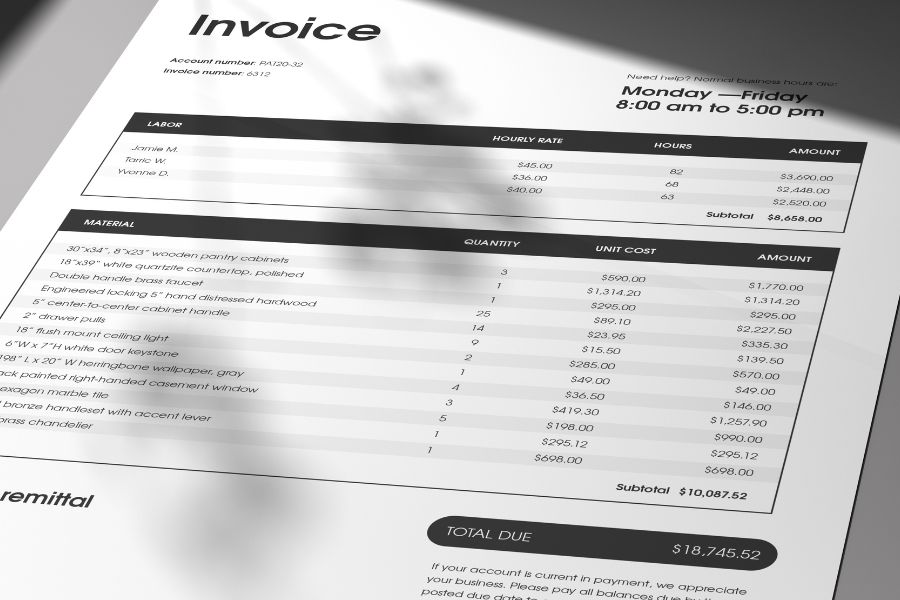For freelancers, online invoicing is a critical aspect of running a successful business. It ensures that you get paid for your work and helps you maintain financial stability.
However, the method you choose for invoicing—whether using online invoicing tools or manual invoicing—can significantly impact your efficiency, accuracy, and overall business operations.
This article explores the pros and cons of online invoicing tools versus manual invoicing, examining which method is better for freelancers and how to choose the right approach for your needs.
By the end, you’ll have a clearer understanding of how to streamline your invoicing process and enhance your freelance business.
1. The Importance of Invoicing for Freelancers
Invoicing is more than just a way to request payment; it’s a crucial part of managing your freelance business. Effective invoicing ensures timely payments, helps you track income and expenses, and maintains a professional relationship with clients.
The method you choose for invoicing can affect your productivity, accuracy, and client satisfaction. Understanding the advantages and disadvantages of online invoicing tools and manual invoicing is essential for making an informed decision.
2. Online Invoicing Tools

Online invoicing tools are software applications designed to automate and streamline the invoicing process. Popular options include FreshBooks, QuickBooks, Zoho Invoice, and Wave.
Let’s explore the advantages and disadvantages of using online invoicing tools.
2.1 Advantages of Online Invoicing Tools
a) Automation and Efficiency
Online invoicing tools automate many aspects of the invoicing process, saving you time and effort.
- Recurring Invoices: Set up recurring invoices for regular clients, reducing the need for manual input.
- Automatic Reminders: Send automatic payment reminders to clients, ensuring timely payments.
b) Professionalism
Online invoicing tools allow you to create professional, customized invoices that reflect your brand.
- Custom Templates: Use customizable templates to create invoices that match your branding.
- Detailed Invoices: Include detailed descriptions, terms, and payment options to provide clarity for clients.
c) Accuracy and Error Reduction
Online tools reduce the risk of errors by automating calculations and data entry.
- Automatic Calculations: Tools automatically calculate totals, taxes, and discounts, minimizing errors.
- Data Sync: Sync data across platforms to ensure consistency and accuracy.
d) Time Tracking and Expense Management
Many online invoicing tools offer integrated time tracking and expense management features.
- Time Tracking: Track billable hours and automatically generate invoices based on time logs.
- Expense Tracking: Record and categorize expenses, making it easier to manage your finances.
e) Payment Integration
Online tools often integrate with payment gateways, making it easier for clients to pay you.
- Multiple Payment Options: Offer clients various payment methods, such as credit cards, PayPal, and bank transfers.
- Faster Payments: Integrated payment options can speed up the payment process, improving cash flow.
2.2 Disadvantages of Online Invoicing Tools
a) Cost
Many online invoicing tools come with subscription fees, which can be a burden for freelancers on a tight budget.
- Monthly Fees: Some tools charge monthly or annual fees, adding to your business expenses.
- Premium Features: Advanced features may require upgrading to a higher-tier plan, increasing costs.
b) Learning Curve
Some online invoicing tools have a steep learning curve, requiring time to master.
- Setup Time: Initial setup and customization can be time-consuming.
- Training: You may need to invest time in learning how to use the tool effectively.
c) Dependence on Technology
Online tools rely on internet connectivity and software reliability, which can sometimes be problematic.
- Internet Issues: Poor internet connectivity can disrupt access to your invoicing tool.
- Software Glitches: Technical issues or software updates can cause temporary disruptions.
d) Data Security
Storing sensitive financial data online comes with security risks.
- Data Breaches: Online tools are vulnerable to data breaches and cyberattacks.
- Privacy Concerns: Ensure the tool you choose has robust security measures in place to protect your data.
3. Manual Invoicing

Manual invoicing involves creating and sending invoices using word processors, spreadsheets, or handwritten documents.
Let’s explore the advantages and disadvantages of manual invoicing.
3.1 Advantages of Manual Invoicing
a) Cost-Effective
Manual invoicing is often free or low-cost, making it accessible for freelancers on a tight budget.
- No Subscription Fees: You don’t need to pay for software or online tools.
- Minimal Resources: All you need is a word processor or spreadsheet software, which you may already have.
b) Full Control
Manual invoicing gives you complete control over the design and content of your invoices.
- Customization: You can create invoices that match your branding and include any details you want.
- Flexibility: Adjust invoices as needed without being constrained by software limitations.
c) No Dependence on Technology
Manual invoicing doesn’t rely on internet connectivity or software reliability.
- Offline Access: You can create and send invoices without needing an internet connection.
- No Technical Issues: Avoid the risk of software glitches or updates disrupting your workflow.
d) Simplicity
Manual invoicing is straightforward and easy to understand, especially for freelancers with simple invoicing needs.
- Ease of Use: No need to learn new software or navigate complex features.
- Quick Setup: You can start creating invoices immediately without any setup time.
3.2 Disadvantages of Manual Invoicing
a) Time-Consuming
Manual invoicing can be labor-intensive, especially if you have multiple clients or complex billing needs.
- Manual Data Entry: You need to manually enter data, calculate totals, and apply taxes or discounts.
- Repetitive Tasks: Creating and sending invoices manually can become repetitive and time-consuming.
b) Error-Prone
Manual invoicing increases the risk of errors, which can lead to payment delays or disputes.
- Calculation Errors: Manual calculations can result in mistakes, such as incorrect totals or tax amounts.
- Data Entry Errors: Typos or incorrect data entry can lead to inaccuracies in your invoices.
c) Lack of Automation
Manual invoicing lacks the automation features that streamline the invoicing process.
- No Recurring Invoices: You need to create and send each invoice manually, even for regular clients.
- No Reminders: You must manually follow up with clients for payment reminders.
d) Limited Professionalism
Manual invoices may lack the professional appearance and features of online invoicing tools.
- Basic Design: Manual invoices may look less professional compared to customized templates from online tools.
- Limited Features: Manual invoices may not include advanced features like payment integration or time tracking.
4. Comparing Online Invoicing Tools and Manual Invoicing
To determine which method is better for freelancers, it’s important to consider the specific dynamics of each approach.
4.1 When Online Invoicing Tools Excel
- Efficiency and Automation – Online tools are ideal for freelancers who need to automate and streamline their invoicing process.
- Professionalism – Online tools offer customizable templates and advanced features that enhance the professionalism of your invoices.
- Accuracy and Integration – Online tools reduce errors and integrate with other business tools, improving overall efficiency.
4.2 When Manual Invoicing Excels
- Cost-Effectiveness – Manual invoicing is ideal for freelancers on a tight budget who prefer a low-cost solution.
- Full Control – Manual invoicing gives you complete control over the design and content of your invoices.
- Simplicity – Manual invoicing is straightforward and easy to use, especially for freelancers with simple invoicing needs.
5. Key Factors to Consider
When deciding between online invoicing tools and manual invoicing, consider the following factors to determine which method is better for your freelance business.
5.1 Business Size and Complexity
Evaluate the size and complexity of your freelance business.
- Small Business: If you have a small number of clients and simple invoicing needs, manual invoicing may suffice.
- Growing Business: If you have multiple clients, recurring invoices, or complex billing needs, online tools may be more efficient.
5.2 Budget
Consider your budget and the cost of online invoicing tools.
- Cost-Conscious: If you’re on a tight budget, manual invoicing may be more affordable.
- Investment-Oriented: If you’re willing to invest in tools that enhance efficiency and professionalism, online invoicing tools may be worth the cost.
5.3 Technical Skills
Assess your technical skills and comfort level with using online tools.
- Tech-Savvy: If you’re comfortable with technology and willing to learn new software, online tools may be a good fit.
- Non-Tech-Savvy: If you prefer simplicity and ease of use, manual invoicing may be more suitable.
5.4 Time Management
Think about how much time you can dedicate to invoicing.
- Time-Saving: If you want to save time and automate repetitive tasks, online tools may be more efficient.
- Hands-On: If you prefer a hands-on approach and don’t mind spending time on manual tasks, manual invoicing may work for you.
Key Takeaways and Recommendations
Deciding between online invoicing tools and manual invoicing depends on your specific needs, budget, and business complexity.
Here are some key takeaways and recommendations to help you choose.
- Choose Online Invoicing Tools If: You value efficiency, professionalism, and automation, and your business has complex invoicing needs.
- Choose Manual Invoicing If: You prefer a low-cost, simple, and hands-on approach, and your business has straightforward invoicing needs.
- Consider a Hybrid Approach: Use online tools for complex tasks and manual invoicing for simpler tasks, depending on your needs.
Conclusion
The choice between online invoicing tools and manual invoicing ultimately depends on your freelance business’s size, complexity, and budget.
Online invoicing tools offer automation, professionalism, and accuracy, making them ideal for freelancers with multiple clients and complex billing needs. Manual invoicing is cost-effective, simple, and gives you full control, making it suitable for freelancers with straightforward invoicing needs.
By carefully evaluating your priorities and testing both methods, you can choose the invoicing approach that best supports your business and enhances your productivity.
Whether you go digital or stick to manual methods, the key is to create an invoicing process that ensures timely payments, maintains client satisfaction, and supports your overall business success.
